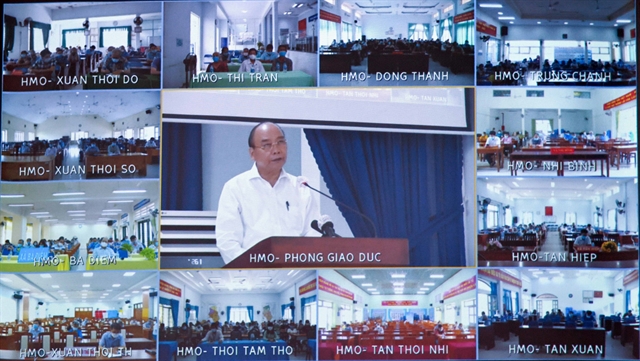 Politics & Law
Politics & Law

State President Nguyễn Xuân Phúc and candidates for the 15th National Assembly met with voters in Củ Chi and Hóc Môn districts of HCM City on May 14-15 via videoconference.

|
| State President Nguyễn Xuân Phúc (centre) presented his action plan during the virtual meeting with voters in HCM City between May 14-15. — VNA/VNS Photo Thống Nhất |
HCM CITY — State President Nguyễn Xuân Phúc and candidates for the 15th National Assembly met with voters in Củ Chi and Hóc Môn districts of HCM City on Friday and Saturday via videoconference.
Presenting his programme of action, President Phúc affirmed that he will do his utmost to serve the nation and people.
He stressed the need for deputies to listen to voters’ aspirations and ideas and report them to the National Assembly, Party, State and relevant agencies, and pay more attention to locals’ substantial socio-economic affairs.
It is also necessary to seek measures to reduce time and costs related to administrative procedures to create favourable conditions for locals and businesses, focus more on improving social welfare, and step up the fight against corruption and wastefulness.
The State leader also requested municipal authorities to invest more in areas with slow development, build strong defence and security, exert efforts to improve the position and prestige of Việt Nam in the international arena and speed up judicial reform.
For Củ Chi and Hóc Môn, the State President said it is necessary to develop general planning for the two districts in the city’s overall master plan to develop them into an ecological urban area during 2030-2045, with the highlight being the Northwest urban area.
On this occasion, President Phúc also visited and met with voters of Division 9 of Army Corps 4, during which he hailed the unit’s contributions to the national construction and defence.
He also visited and presented gifts to several policy beneficiaries in Củ Chi and Hóc Môn districts. VNS
PM asks for budget retention rate increase HCM CITY — Prime Minister Phạm Minh Chính has asked the National Assembly to allow HCM City to retain 23 per cent of its budget revenues, up from the previous 18 per cent, to create conditions for sustainable development, he said during a meeting with the city’s leaders held last week. HCM City is the country’s economic powerhouse with a significant GDP contribution to the national budget, the PM said. Professor Trần Hoàng Ngân, director of the HCM City Development Research Institute, said the decision would help resolve a number of challenges related to road infrastructure, social security, healthcare, and other issues. “If the city received a 1 per cent increase in retained revenue, it would then have an additional VNĐ2 trillion (US$86.748 million), and an increase of 5 per cent would yield an additional VNĐ10 trillion.” Dr. Huỳnh Thế Du, public policy lecturer at Fulbright University, said the city needs to be highly competitive to attract large businesses, a highly skilled workforce, and well-off people compared to other cities in the region and in the world. China, for example, has spent a lot of resources on big cities, he added. At a recent meeting with the PM, Nguyễn Thành Phong, chairman of the city People’s Committee, proposed that the government approve the budget retention rate of 23 per cent instead of the current 18 per cent over the next five years. “HCM City has one of the lowest budget retention rate of all cities in the world, and this should change,” Phong said. The city contributes 27 per cent to the national budget, and has the lowest retention rate in the country. In the first four months, the city posted a budget collection of VNĐ140 trillion ($6 billion), up 15.7 per cent year-on-year, Phong said. The low budget retention rate has prevented the southern financial hub from addressing traffic jams and school shortages. With only 9 per cent of Việt Nam’s total population, the city contributes 24 per cent of the country’s GDP. Experts said the city does not have enough money to build more roads as the percentage of retained budget revenue is too low. The city also needs 10,000 additional classrooms every half decade to keep pace with the population increase, with each classroom hosting a standard 30 students. It currently has to pack 40-60 students into a single room, they said. Budget retention ratios for Hà Nội, Hải Phòng, Đà Nẵng and Cần Thơ for the 2016-2020 period are 35, 78, 68, and 91 per cent, respectively, far above HCM City. With a 30 per cent retention rate, Tokyo ranks just above HCM City, with Oslo the highest at 60 per cent. According to the Department of Planning and Investment, the city’s total retail sales of goods and revenue from consumer services in the first four months was up 7.9 per cent year-on-year. The city’s Gross Regional Domestic Product (GRDP) reached VNĐ329.6 trillion in the first quarter, up 4.58 per cent year-on-year. — VNS |




